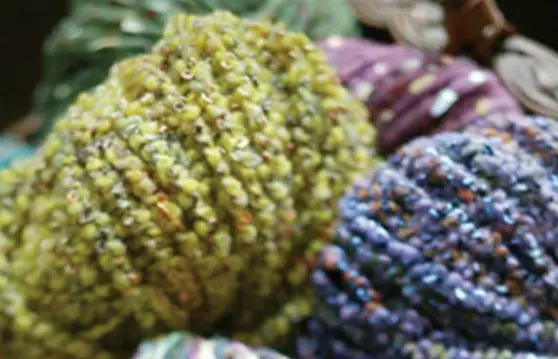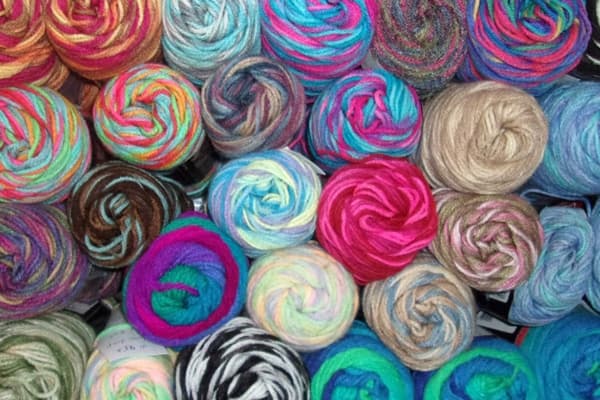Have you ever looked at a piece of woven fabric and been captivated by its unique texture and visual depth? Often, that special quality comes from using what we in the industry call "novelty yarns." As a manufacturer and supplier, my name is Allen, and for years I’ve helped clients across North America and Europe source the perfect yarns for their projects. Novelty yarns are the creative powerhouses of the textile world. They are the yarns that come with built-in character, designed to add texture, color, and personality to any woven fabric. This guide is for procurement officers, textile designers, and anyone curious about how these special yarns can elevate a standard weave into something extraordinary. We will explore what they are, how they’re made, and how you can use them to create truly unique textiles.
What Exactly Makes a Yarn a "Novelty Yarn"?
A novelty yarn is essentially any yarn that is intentionally designed with irregularities, textures, or color effects that set it apart from a standard, uniform yarn. While a conventional yarn aims for smoothness and consistency, a novelty yarn celebrates imperfections. Think of it as the difference between a smooth, paved road and a charming cobblestone street. Both are functional, but one has a lot more character. These specialty yarns are created to produce interesting effects in fabrics.
Unlike standard yarns spun for uniformity, novelty yarns are made by introducing deliberate variations during the spinning or plying of the yarns. This can result in a yarn with thick-and-thin sections (slubs), loops (bouclé), fuzzy textures (chenille), or even metallic or ribbon-like elements. These yarns are known for their decorative qualities and are a key tool for designers looking to add visual interest and a unique feel to their products. The main purpose of a novelty yarn is aesthetic; it’s all about the look and feel it brings to the final textile.
These fancy yarns, as they are also called, can be made from a wide range of fibers, including natural fibers like cotton and wool, or man-made fibres like polyester and acrylic. The novelty aspect comes not from the type of fiber itself, but from the structure of the yarn. They are yarns designed to stand out. This type of yarn is all about creating a unique texture and enhancing fabric appearance.
How are Most Novelty Yarns Made?
The creation of a novelty yarn is a fascinating process that often involves combining multiple strands. Most fancy yarns are generally produced using a method that involves three key components, which are twisted together to form a composite yarn structure. Understanding this helps you appreciate the complexity and artistry behind each skein.
- The Base or Core Yarn: This is the foundation of the
yarn. It provides strength and structure. The coreyarn is usuallya standard, smoothply yarn. - The Effect Yarn: This is the star of the show! The
effect yarnis what creates thenoveltylook. It’s fed at a different speed than the coreyarn, causing it to create loops, slubs, or other textures as it wraps around the base. - The Binder Yarn: This is a fine, often nearly invisible
yarnthat is twisted in the opposite direction of theeffect yarn. Its job is to hold theeffect yarnin place and secure the loops orslubsto the coreyarn, ensuring thenovelty effectdoesn’t fall apart during weaving, knitting, orcrochet.
This three-part structure is common for bouclé, spiral, and loop yarns. Other novelty yarns, like a slub yarn, are created differently. For a slub yarn, the spinning process is intentionally varied to produce thicker, less-twisted sections (slubs) at irregular intervals along the yarn. Chenille yarns are made by locking short lengths of fibre between two twisted core yarns, creating that iconic soft, fuzzy texture.

What are the Most Common Types of Novelty Yarns Used in Weaving?
The world of novelty yarn is vast and exciting. When sourcing yarns for weaving, clients often ask me to identify different textures. Here are some of the most popular common types you’ll encounter, each offering a distinct texture and visual appeal.
| Type of Novelty Yarn | Description | Best Used For in Weaving |
|---|---|---|
| Bouclé Yarn | Made with loops that range from tiny circles to large, loopy curls. Known for its pebbly texture. |
Weft for coats, upholstery, pillows. |
| Slub Yarn | A yarn with thick, soft sections (slubs) interspersed with thinner areas. |
Weft for casual apparel, curtains. |
| Chenille Yarns | Has a fuzzy, caterpillar-like texture. Incredibly soft with a beautiful drape and sheen. |
Weft for blankets, scarves, upholstery. |
| Ribbon Yarns | A flat, ribbon-like yarn, often made of cotton, rayon, or silk. |
Weft for decorative accents, bags. |
| Spiral Yarns | Two plied yarns of different thicknesses are twisted together to create a corkscrew effect. |
Weft for textured throws and apparel. |
| Thick-and-Thin | Similar to slub yarn, but with more dramatic and gradual transitions between thick and thin. |
Weft or carefully in warp for art yarn. |
Beyond these, you’ll find everything from crepe yarns (highly twisted for a crinkled texture) to stretch yarns with elastic cores. The yarn collection of any major textile manufacturer will include a variety of these fancy yarns to meet diverse design needs. These yarns provide endless creative opportunities.
Why Should You Use Novelty Yarns in Your Weaving Projects?
The primary reason to use novelty yarns is to add texture and visual effects in fabrics. In a competitive market, a unique textile can make a product stand out. A simple plain weave can be completely transformed by using a bouclé yarn in the weft, turning a flat fabric into a rich, textured material perfect for high-end apparel or home decor. Novelty yarns break the monotony of a smooth surface.
For business owners like Mark Thompson, who I often work with, using novelty yarn is a strategic choice. It can elevate a product line with minimal changes to the manufacturing process. By simply swapping a standard weft yarn for a novelty yarn, you can create a new product with a higher perceived value. These yarns add dimension and a tactile quality that customers are drawn to. They are a designer’s secret weapon for creating signature fabrics. The yarn itself does the heavy lifting, creating complex-looking woven fabric with simple weaving techniques.
Furthermore, these yarns are often used for decorative purposes. A few strategically placed stripes of a fancy or metallic yarn can add a touch of luxury and sophistication. They allow for an immense amount of creativity, whether you’re designing for fashion, home furnishings, or art textiles.
Can You Safely Use Novelty Yarns for Warp Threads?
This is a critical question I receive from weavers and textile factories alike. The warp is the set of lengthwise yarns that are held under high tension on a loom. Therefore, the yarn used for the warp must be strong, smooth, and consistent to withstand the friction and stress of the weaving process.
Generally, most novelty yarns are not suitable for warp. Here’s why:
- Strength: The slubs, loops, and thin sections of a
novelty yarncreate weak points. Theyarn maybreak under tension. - Friction: The irregular textures can get caught in the heddles and reed of the loom, causing snags, sheds that don’t open cleanly, and a lot of frustration. A
bouclé yarn, for example, would be a nightmare as a warpyarn. - Inconsistency: The varying thickness makes it nearly impossible to achieve an even tension across the entire warp, which is crucial for a well-balanced
woven fabric.
However, there are exceptions. Some smoother, stronger novelty yarns, like a slub yarn with very minor variations, might be usable for novelty yarns for warp, especially in handweaving where the weaver can manually fix any issues. Some art yarns are specifically designed with a strong core to be used in the warp. But for commercial production, it is almost always recommended to use novelty yarns in the weft only, where the yarn is not under constant tension. The weft is where the novelty yarn can truly shine without compromising the structural integrity of the fabric.

What are the Best Practices for Weaving with Specialty Yarns?
When you decide to weave with novelty yarns, a few adjustments to your process can ensure a beautiful result. Since these yarns are typically used as weft yarns, the focus is on how you lay them into the fabric.
First, pay close attention to your beat. The "beat" is the action of pushing the weft yarn into place. With a highly textured yarn, you might want to use a lighter beat than you would with a smooth yarn. A gentle beat allows the texture of the yarn—the loops of bouclé or the puffs of a slub—to sit on the surface of the fabric rather than being packed down and hidden. The goal is to showcase the yarn, not flatten it.
Second, consider your sett, or the spacing of your warp threads. A slightly more open sett can give a bulky novelty yarn more room to breathe and show off its texture. Finally, be mindful of your edges (selvedges). Some novelty yarns can be bulky or slippery, making neat edges a challenge. Maintaining consistent tension and paying extra attention as you enter and exit the shed will help. For large-scale production, this is where machine calibration becomes essential to handle the unique properties of the fancy yarns.

How Do Novelty Yarns Change the Final Woven Fabric?
The impact of a novelty yarn on the final woven fabric is dramatic. It’s not just about looks; it’s about the physical properties of the textile as well. A yarn with loops, like bouclé, will create a fabric with a three-dimensional, pebbly surface that is both visually interesting and tactile. It also traps air, which can make the fabric warmer.
A slub yarn creates a fabric with a rustic, linen-like appearance, adding a subtle, organic texture. Chenille yarns result in a fabric with a velvety pile and a very soft hand-feel, perfect for items meant to be cozy and luxurious. The yarn is one of the most important factors determining the final character of a fabric.
It’s also important to consider drape. A fabric woven with a bulky, highly textured yarn will likely be stiffer and have more body than one woven with a fine, smooth yarn. This is a critical consideration for garment manufacturing. You wouldn’t use a stiff, heavy bouclé for a flowy dress, but it would be perfect for a structured jacket. The type of novelty yarn you choose directly influences the final application of your woven fabric. These yarns tend to create heavier, bulkier fabrics.
Is it a Good Idea to Mix Novelty and Conventional Yarns?
Mixing novelty yarns with conventional, smooth yarns is not just a good idea—it’s one of the best ways to use them! It’s rare that novelty yarns are seldom used to make an entire fabric from warp to weft. In fact, they are often used to create specific effects and are seldom used to make an entire piece on their own, especially in commercial applications.
A common and highly effective technique is to use a standard, strong yarn for the warp—like our durable 100% spun polyester yarn—and then alternate the novelty yarn with a smooth conventional yarn in the weft. This creates stripes or blocks of texture within a stable, well-structured fabric. This method offers several benefits:
- Cost-Effectiveness:
Novelty yarnsare often more expensive. Mixing them with more economicalyarnsallows you to get the desiredfancy effectswhile managing costs. - Stability: The smooth
yarnprovides a stable structure that supports the more delicate or irregularnovelty yarn. - Design Control: It gives you precise control over where the
textureappears, allowing you to create sophisticated patterns and designs.
You can mix two or more types of yarn to create incredibly unique fabrics. For example, a weaver might use a smooth cotton yarn for 8 picks of the weft, followed by 2 picks of a chunky bouclé yarn, creating a beautiful pinstripe texture.
What are the Sourcing Challenges with Novelty Fibre Yarns?
For procurement officers, sourcing novelty yarns can present unique challenges compared to standard yarns. One of the biggest pain points my clients face is consistency. Because novelty yarns are intentionally irregular, ensuring that the slubs or loops are consistent from one dye lot to the next can be difficult. This is why it’s crucial to work with a reputable manufacturer who has strong quality control processes.
Another challenge is accurately predicting performance. A textured yarn might behave differently on different types of looms. We always recommend ordering samples and running tests before committing to a large production run. This helps identify any potential issues with tension, friction, or the final fabric appearance.
Finally, the yarn costs can be higher due to the more complex manufacturing process. However, as I always discuss with clients, this initial cost is often offset by the higher value and unique appeal of the final product. The key is finding a supplier who can provide a quality, consistent yarn at a competitive price, ensuring your production remains profitable. Communication is key to navigating these challenges successfully.
How Do You Choose the Right Novelty Yarn for Your Textile Project?
Choosing the right novelty yarn comes down to understanding the desired outcome for your textile. Start by asking yourself a few key questions:
- What is the end-use? Is it for apparel, upholstery, or a decorative item? A soft
chenilleis great for a blanket but would not be durable enough for upholstery. A sturdyboucléwould be the better choice. - What
textureare you trying to achieve? Do you want a subtle, organictexture(slub yarn) or a bold, loopytexture(bouclé yarn)? - What are the care requirements? Make sure the
fibrecontent of thenovelty yarnis appropriate for the intended care of the final product. Mixing a hand-wash woolyarnwith machine-washablesynthetic fibersmeans the entire item becomes hand-wash only. - What is your budget? Some
novelty yarnsare significantly more expensive than others. Decide if you will use theyarnthroughout the weft or as a more limited accent to manage costs.
My best advice is to get your hands on samples. There is no substitute for seeing and feeling the yarn. Drape it, weave a small sample, and see how it behaves. As a supplier, providing detailed specs and physical samples is a standard part of our process to ensure our clients can make informed decisions and create the best possible product. The right yarn is out there, and finding it is the first step to a successful weave.
Key Takeaways
Working with novelty yarns opens up a world of creative possibilities in weaving, allowing you to design fabrics that are rich in texture and visual interest.
- Definition: A
novelty yarnis intentionally designed with irregularities like slubs, loops, or fuzz to create a decorative effect. - Construction: Most are made with a core, an
effect yarnthat creates the texture, and a binderyarnto hold it all together. - Best Use: They are almost always
used in weavingas the weftyarn, as they are generally not strong enough for the high-tension warp. - Mixing is Key: Combine
novelty yarnswith conventional, smoothyarnsto create stable, cost-effective, and beautifully textured fabrics. - Sourcing and Testing: Work with a reliable supplier and always test a sample
yarnbefore committing to a large production run to ensure consistency and performance. - Choose Wisely: Select your
novelty yarnbased on the final product’s desiredtexture, drape, durability, and care requirements.





